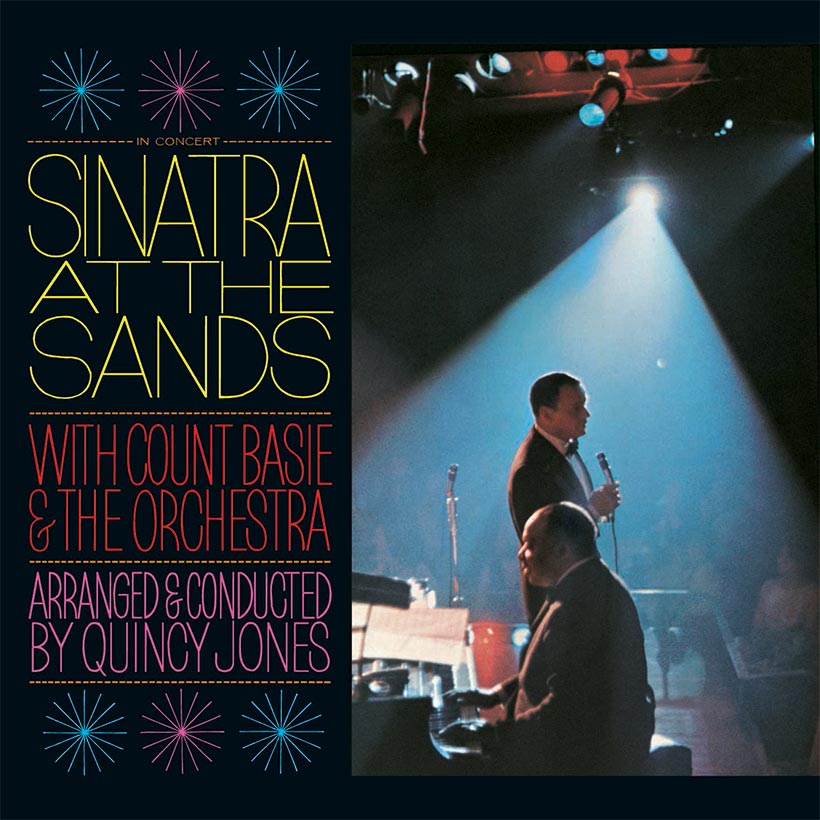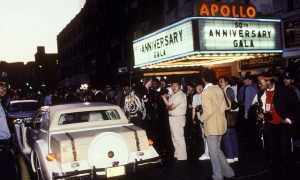“How did all these people get in my room?” So quips an ebullient Frank Sinatra when he walks out on to the Copa Room stage at The Sands Hotel And Casino in Las Vegas. Behind him, Count Basie’s orchestra are revving up with a hard-swinging, foot-tapping intro that seamlessly morphs into a turbo-charged version of “Come Fly With Me.” Powered by Norman Keenan’s walking bassline, the song’s irresistible, kinetic groove – over which Sinatra’s voice glides effortlessly – feels like its propelled by jet fuel. It’s a stunning way to open Sinatra’s first-ever live album, Sinatra At The Sands.
Listen to Sinatra At The Sands on Apple Music and Spotify.
Issued in July 1966 as a double album on The Chairman’s own Reprise label, Sinatra At The Sands was seamlessly assembled from a week’s worth of shows recorded during a seven-night stint in Vegas, which lasted from January 26 to February 1, 1966.
It’s hard to believe that Frank Sinatra had notched up half a century of birthdays (he was 50 the previous December) without making a live album – he had, after all, been a professional singer since 1935 and a solo recording artist since 1943. But that changed in 1966 when he joined forces with the legendary Count Basie and his band in Vegas.
The fact that Sinatra chose to record his first in-concert album in tandem with the Rolls Royce of big bands illustrates how much he appreciated performing with Basie’s slick and sophisticated, super-tight ensemble.
They had, of course, recorded together before, but only in the studio. Their first collaboration was 1962’s Sinatra-Basie: An Historical First album, followed in 1964 by It Might As Well Be Swing, the latter with arrangements by Quincy Jones. Later, in the summer of 1965, Sinatra and Basie performed several concerts with Jones conducting. By the time that the Sands dates were booked, in early ’66, Sinatra and Basie were, musically, perfectly attuned to each other.
Sinatra At The Sands was recorded at a time when long-haired pop and rock groups – epitomized by The Beatles and The Beach Boys – were changing the face of music. 1966 was, after all, the age of game-changing albums such as Revolver and Pet Sounds, but in the Copa Room, in Sinatra’s presence, none of that seemed to matter. The audience were in Frank’s world, where the music swung, the songs were timeless, the jewelry dazzled, and the booze flowed. Time stood still.
On Sinatra At The Sands, the golden age of saloon singing is brought vividly to life. With Quincy Jones conducting and providing scintillating charts, Sinatra is in tremendous form. As the arranger recalled in his book, Q: The Autobiography Of Quincy Jones, “Frank was at the height of his powers then, and I was steering his musical ship, the greatest band in the world.”
Sinatra swings with a finger-clicking pizzazz, as “Fly Me To The Moon,” then a new song in his repertoire, clearly demonstrates; on the ballads, he shows that, despite the jokey asides between songs, he’s deadly serious and deeply sensitive. Of these, “One For My Baby (And One More For The Road)” is particularly noteworthy. Sinatra introduces the song by saying, “This is the part of the program where we sing a drunk song,” a wisecrack which elicits chuckles from the audience. Once he starts singing, however, the room succumbs. You could hear a pin drop as Sinatra, accompanied by Bill Miller’s lone piano, transforms Harold Arlen and Johnny Mercer’s barroom nocturne into a desolate hymn for perennial losers.
In sharp contrast, “The Tea Break” comes across almost like a Sinatra stand-up routine: a 12-minute monologue packed with gags, some of which are daringly risqué, targeting himself and fellow Rat Packers Sammy Davis Jr and Dean Martin. “If we ever develop an Olympic drinking team, he’s gonna be the coach,” quips Sinatra, alluding to his friend’s purported partiality for strong liquor.
Sinatra At The Sands is also notable for introducing a brand new song, Johnny Mandel’s “The Shadow Of Your Smile.” Featured on the soundtrack to the 1965 movie The Sandpiper, Sinatra only learned the song at the last minute for his 1966 Sands shows, but, such is the form he’s in, he nevertheless delivers a definitive performance. Elsewhere, Basie’s band get a chance to shine on their own with a brief but climactic snippet of “One O’Clock Jump” and a complete version of “All Of Me,” but they are at their most potent when working in tandem with Sinatra.
The third of four LPs that Ol’ Blue Eyes released in 1966 (it followed hot on the heels of the chart-topping Strangers In The Night), Sinatra At The Sands peaked at No.9 in the US album charts, on October 15, 1966, and eventually went gold. Those who had predicted the demise of easy-listening music at the hands of the beat groups were wrong. Sinatra At The Sands proved that, even at 50, The Chairman remained a force to be reckoned with.
Still, arguably the definitive Sinatra live album, Sinatra At The Sands is also, indisputably, one of the greatest in-concert albums by anyone, offering a compelling on-stage portrait of a performer at the peak of his powers, able to make every person in the Vegas audience think they’ve hit the jackpot just by being in his presence. You can still feel that today: Sinatra At The Sands remains a classic album that vividly brings to life the last days of his Rat Pack empire.




